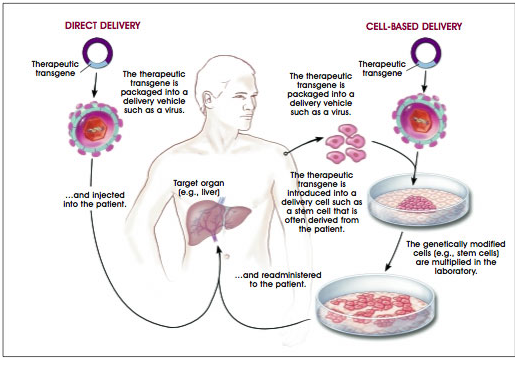Genes are made of deoxyribonucleic acid (DNA) molecules – which are the main genetic material of living cells. It is in the gene that the genetic information that directs the activities of a cell is located; and this genetic information also direct the production of malfunctioned proteins or activities that result in genetic disorder in a living host.
Successful gene delivery requires an efficient way to get the DNA into living host cells; and to make it happen, a vector (usually a virus) is used to deliver the gene of interest into the host receiving the gene therapy. These DNA delivery vehicles or systems are known generally as vectors.
Vectors are cloning agents that act as self-replicating DNA molecules, and which is used in molecular biology techniques to carry cloned genes or other segments of DNA into another recipient host. It is noteworthy to note that in parasitology, a vector may mean an agent which is usually an insect or animal that is able to carry infectious disease agents or pathogens from one host to another.
To be successful in gene therapy techniques, a vector must be able to target the right type of cells in the recipient host. It must be able to integrate the gene or DNA it is carrying into the host cell. Vectors must leave no untoward effect on the recipient host and the vector must also be able to activate the gene once it has entered the host cell.
The inserted desired gene must go to the nucleus of the target host cell and be “turned on. For a gene to be turned on, it means that the gene is transcribed and translated (according to the central dogma of molecular biology as aforesaid) in order to make the desired protein product that the inserted gene encodes. And for the gene delivery process to be successful, the protein must function properly in the recipient host cell.
Gene therapy as aforementioned is the addition of new genes to a patient’s cells to replace missing or malfunctioning genes – as a panacea to correcting a particular molecular/genetic disease or disorder.
It is usually done using a virus to carry the genetic cargo into cells, because that’s what viruses evolved to do with their own genetic material. A vector which can be viral or nonviral vector carrying the desired gene or DNA is used to deliver the functional/normal gene into the recipient patient’s target cell or tissues.
The vector carrying the therapeutic gene (viral vector in particular) infects and invades the non-functional tissue or cell, and transforms it. Particularly, the viral vector (harbouring the therapeutic DNA) uncoats and releases the therapeutic gene into the host cell genome.
Taking control of the infected host cell’s genome, the therapeutic gene starts to synthesize functional or normal genes which bring about the desired effect by replacing the non-functional gene product or repairing the defective gene; and this returns the diseased target cell to its normal physiological function. The major differences between viral and non-vectors used for gene therapy applications are as shown in Table 1.
Table 1. Difference between viral and non-viral vectors
| S/No. | Viral vectors | Non-viral vectors |
| 1. | Highly efficient in transferring desired genes. | Less or fairly efficient in transferring desired genes. |
| 2. | Viral vectors pose some health risk to the recipient Patient. | Non-viral vectors are usually safer to use, and they do not pose any health risk to the recipient patient. |
| 3. | Viral vectors are used for in vivo gene therapy to deliver desired genes through the process of transduction. | Non-viral vectors are used for ex vivo gene therapy to deliver desired genes through the process known as transfection. |
| 4. | Viruses (e.g. adeno-associated viruses and adenoviruses) are used as vectors. | Non-viral vectors such as gene gun or microinjection and calcium phosphate precipitate e.t.c. are used as vehicles to convey the gene of interest into the body of the host. |
References
Alberts B, Bray D, Johnson A, Lewis J, Raff M, Roberts K and Walter P (1998). Essential Cell Biology: An Introduction to the Molecular Biology of the Cell. Third edition. Garland Publishing Inc., New York.
Dale J (2003). Molecular genetics of bacteria. Jeremy W. Dale and Simon Park (4th eds.). John Wiley & Sons Ltd, West Sussex, UK.
Edelstein, M. L., Abedi, M. R., Wixon, J., and Edelstein, R. M. (2004). Gene therapy clinical trials worldwide 1989-2004—an overview. J Gene Med, 6: 597-602.
Ferrua, F.; Brigida, I.; Aiuti, A. (2010). Update on gene therapy for adenosine deaminase-deficient severe combined immunodeficiency. Current Opinion in Allergy and Clinical Immunology. 10 (6): 551–556.
Gardlík R, Pálffy R, Hodosy J, Lukács J, Turna J, Celec P; Pálffy; Hodosy; Lukács; Turna; Celec (2005). Vectors and delivery systems in gene therapy. Med Sci Monit. 11 (4): RA110–21.
Horn PA, Morris JC, Neff T, Kiem HP; Morris; Neff; Kiem (2004). Stem cell gene transfer—efficacy and safety in large animal studies. Mol. Ther. 10 (3): 417–31.
S Li and L Huang (2000). Nonviral gene therapy: promises and challenges. Gene Therapy, 7:31-34. www.nature.com/gt
Salmons B, Günzburg WH; Günzburg (1993). Targeting of retroviral vectors for gene therapy. Hum Gene Ther. 4 (2): 129–41.
Sambrook, J., Russell, D.W. (2001). Molecular Cloning: a Laboratory Manual, 3rd edn. Cold Spring Harbor Laboratory Press, New York.
Sheridan C (2011). Gene therapy finds its niche. Nature Biotechnology. 29 (2): 121–128.
Tamarin Robert H (2002). Principles of Genetics. Seventh edition. Tata McGraw-Hill Publishing Co Ltd, Delhi.
Twyman R.M (1998). Advanced Molecular Biology: A Concise Reference. Bios Scientific Publishers. Oxford, UK.
Vannucci, L; Lai, M; Chiuppesi, F; Ceccherini-Nelli, L; Pistello, M (2013). Viral vectors: A look back and ahead on gene transfer technology. The new microbiologica. 36 (1): 1–22.
Discover more from Microbiology Class
Subscribe to get the latest posts sent to your email.




